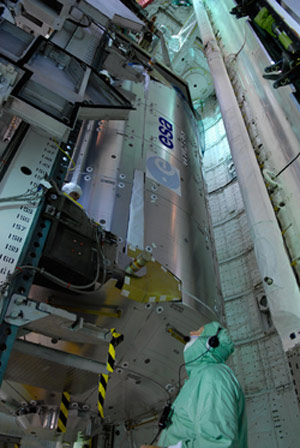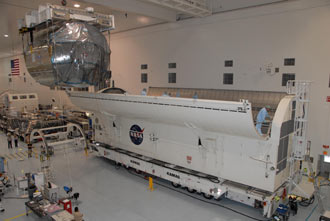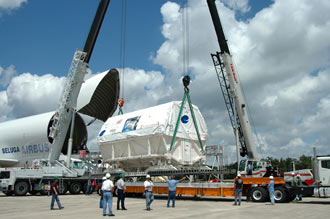The laboratory will be brought to the station on the space shuttle Atlantis as part of the STS-122 operation * The launch - on Thursday, 23:31 pm Israel time

Image 1:
Preparations for launch: A NASA employee helps guide the Columbus Laboratory into the loading dock of the Space Shuttle Atlantis. Image courtesy of NASA / Kim Shifflett.
Columbus is the European Space Agency's space research laboratory, a culmination of the design and engineering work that went into creating Europe's major contribution to the space station.
The laboratory is designed in the shape of a cylinder, 6.9 meters long and 5 meters in diameter. It is designed to store unique experiments that will test how humans react to lack of gravity, and how space affects liquids and different objects, such as crystals. On the outer side of the laboratory, which faces space, there are two stations that can be used for the study of various materials as well as for observations in space. The laboratory allows researchers to conduct a large number of new studies in space, and European scientists hope to utilize its services throughout the next decade.
"For us, this is an opportunity to have long-term access to space," said Gregor Woop, director of quality control at the European Space Agency. "There is an opportunity here for scientific institutions to send experiments and run them on board the laboratory."
Columbus will join NASA's Destiny Laboratory, which was launched into orbit in 2001. Next year, a series of space shuttle missions will carry parts of the Japanese laboratory into orbit. The three research laboratories, which are in orbit around the Earth, will enable a leap forward in space exploration.
The European Space Agency, in which 17 countries are members, also built an information center that is supposed to manage the research on Columbus and collect the results of the research. The Columbus control center will be located in Oberpachpenhofen, Germany, and will join a global network of space station control centers, which includes the NASA centers in Houston and Huntsville, Alaska, and the Russian control center near Moscow.
Although the Columbus module is considered the most sophisticated space station module the European Space Agency has built, it is not the first. Space shuttles used space labs as space research centers between 1983 and 1998. The two most useful modules were built so that they could fit into the cargo hold of the shuttles. Unlike Columbus, which will remain in space permanently, the previous space labs remained inside the shuttles during the mission, and the shuttle crews conducted the research during the two-week flight.
Like previous space labs, Columbus was designed to support astronauts. The Columbus is full of piping and piping designed to maintain the activity of life support systems inside the module, and to enable the scientific experiments inside. "It's actually a tiny space station," Woop said.
Designing the station as a module capable of supporting both experiments and humans proved to be a difficult challenge for the engineers, due to the lack of space. "This is a well-organized laboratory," said Alessio Festa, Columbus' director of mechanical design.
The problem was solved by a unique design of the laboratory. Experiments and equipment are organized in cabinets the size of refrigerators. The astronauts in space can easily switch between the cabinets because they weigh nothing. On Earth, the cabinets can be loaded with equipment, and the astronauts in orbit will handle the various experiments, switching between the cabinets that need treatment at that moment.
Columbus can hold 10 test pods, but will launch with only five. More cabinets will be launched in future missions.
After assembling the laboratory in Italy, and equipping it in Germany, Columbus was flown by plane across the Atlantic Ocean to NASA's Kennedy Space Center in Florida, where it will undergo final tests and a leak test.
For information on the NASA website

A crane lifts the Columbus and puts it in a special carrying box, which will then be taken by the launch of the space shuttle Atlantis. Image courtesy of NASA / George Shelton.

Columbus was carried into an Italian cargo plane destined to be brought from Germany to the Kennedy Space Center. Image courtesy of NASA / Jim Grossman.

One response
For Roy, the launch was postponed until tomorrow at least